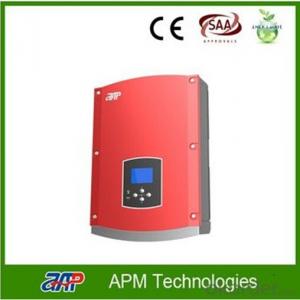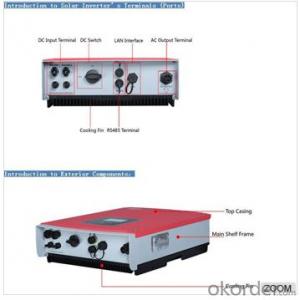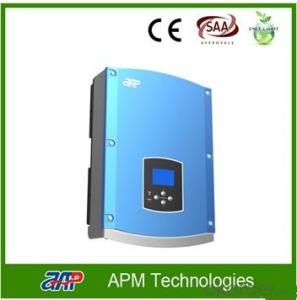Pv Inverter Single Phase Solar Inverter 1500W On Grid
- Loading Port:
- China main port
- Payment Terms:
- TT or LC
- Min Order Qty:
- 15000 watt
- Supply Capability:
- 3000000 watt/month
OKorder Service Pledge
OKorder Financial Service
You Might Also Like
1. Structure of Pv Inverter Single Phase Solar Inverter 1500W On Grid Description
1) Transformerless single phase on Grid pv Inverter
2)12v DC to 220v AC 1500W 50Hz/60Hz Solar Power Inverter, Pure Sine Wave Inverter.
3) IP 65 1500w On grid Pv Solar Inverter.
2. Main Features of the Pv Inverter Single Phase Solar Inverter 1500W On Grid
﹒High quality .
﹒competitive wholesale price.
﹒5years warranty
﹒Power Factor:>0.99 with nominal AC current
﹒AC Voltage Range:150V-550Vac
﹒Nominal AC Power:1500W
3. Pv Inverter Single Phase Solar Inverter 1500W On Grid Images

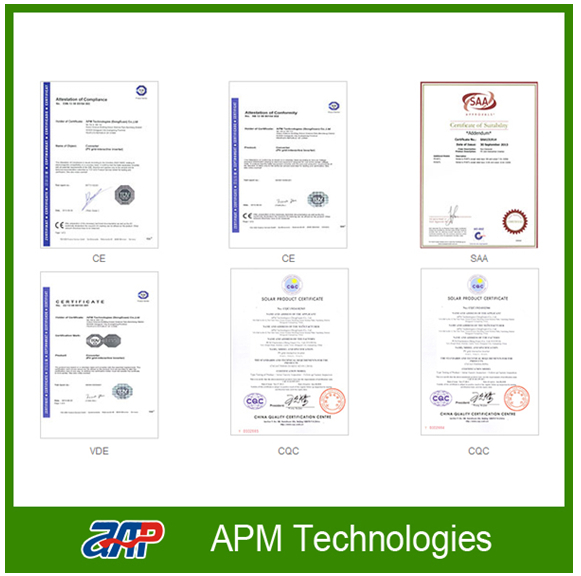
4. Pv Inverter Single Phase Solar Inverter 1500W On Grid Specification
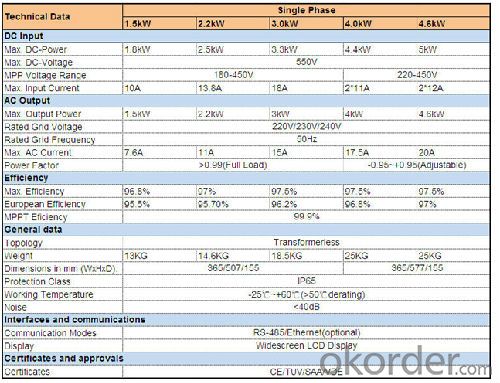
5. FAQ of Pv Inverter Single Phase Solar Inverter 1500W On Grid
Q1. What is the difference between inverter and solar inverter?
A1. Inverter only has AC inpput, but solar inverter both connect to AC input and solar panel, it saves more power.
Q2. What is the difference between MPPT&PWM?
A2. MPPT has higher efficiency, it can track the max power point and won't waste energy.
Q3. What is the waranty of product?
A3. 5 years .
- Q:How does the input voltage range affect the performance of a solar inverter?
- The input voltage range of a solar inverter directly impacts its performance. A wider input voltage range allows the inverter to adapt to various solar panel configurations and environmental conditions, maximizing the system's overall efficiency. A limited input voltage range may result in reduced efficiency and output power, as the inverter may not be able to effectively convert the varying voltages produced by the solar panels. Additionally, a wider input voltage range provides flexibility in system design and allows for the incorporation of additional solar panels in the future without the need for significant modifications.
- Q:Can a solar inverter be used in a commercial solar system?
- Yes, a solar inverter can be used in a commercial solar system. In fact, it is an essential component as it converts the direct current (DC) generated by the solar panels into alternating current (AC) that can be used to power commercial buildings and equipment. The solar inverter ensures efficient and reliable energy conversion, making it suitable for both residential and commercial solar installations.
- Q:Can a solar inverter be used with a solar-powered backup generator?
- Yes, a solar inverter can be used with a solar-powered backup generator. A solar inverter is responsible for converting the DC (direct current) electricity generated by solar panels into AC (alternating current) electricity that can be used to power household appliances and other electrical devices. A solar-powered backup generator, on the other hand, uses solar energy to charge its batteries or store excess electricity. When the solar panels are generating electricity, the solar inverter will convert the DC electricity into AC electricity, which can be used directly in the household or sent back to the grid if the system is connected to it. If there is excess electricity being generated and the batteries of the solar-powered backup generator are fully charged, the solar inverter can divert the excess electricity to other loads or devices. During periods when solar energy is insufficient or not available, the solar-powered backup generator can kick in and provide the necessary electricity to power the house or recharge the batteries. In this case, the solar inverter will still be responsible for converting the DC electricity generated by the solar-powered backup generator into AC electricity. So, to summarize, a solar inverter can definitely be used with a solar-powered backup generator to ensure a continuous supply of electricity even when solar energy is limited.
- Q:Are solar inverters weather-resistant?
- Yes, solar inverters are designed to be weather-resistant. They are typically built with durable materials and sealed enclosures to protect them from various weather conditions such as rain, snow, and extreme temperatures. However, it is always recommended to consult the manufacturer's specifications and guidelines to ensure proper installation and maintenance for optimal performance and longevity.
- Q:How does a solar inverter handle voltage and frequency variations caused by grid disturbances?
- A solar inverter is designed to handle voltage and frequency variations caused by grid disturbances by regulating and stabilizing the incoming AC power from the grid. It constantly monitors the voltage and frequency levels of the grid and adjusts its internal components accordingly to ensure that the power being generated by the solar panels is synchronized with the grid. In cases of voltage or frequency deviations, the inverter employs advanced control algorithms to rectify the imbalances and maintain a steady flow of power to the grid. This helps to protect the electrical appliances and equipment connected to the grid from potential damage and ensures the stability and reliability of the overall power system.
- Q:How does a solar inverter handle voltage and frequency variations caused by switching operations?
- A solar inverter handles voltage and frequency variations caused by switching operations through the use of advanced control algorithms and circuitry. It continuously monitors the input voltage and frequency from the solar panels and adjusts its own output voltage and frequency accordingly. This ensures that the power generated by the solar panels is efficiently converted into usable AC power that matches the grid requirements. The inverter's voltage and frequency control mechanisms help maintain a stable and consistent power supply, even in the presence of switching operations or fluctuations in the solar panel output.
- Q:Can a solar inverter be used with a monitoring system?
- Yes, a solar inverter can be used with a monitoring system. In fact, many solar inverters come with built-in monitoring capabilities or can be easily integrated with external monitoring systems. These monitoring systems allow users to track the performance of their solar panels, monitor energy production, and detect any potential issues or faults in real-time. This helps users optimize their solar energy generation and ensure the system is operating efficiently.
- Q:What is the purpose of a solar inverter in a solar power system?
- The purpose of a solar inverter in a solar power system is to convert the direct current (DC) electricity produced by solar panels into alternating current (AC) electricity, which is the type of electricity used in most household appliances and the power grid.
- Q:How do you connect a solar inverter to the electrical grid?
- To connect a solar inverter to the electrical grid, you need to follow a few steps. Firstly, you need to ensure that your solar inverter is compatible with grid connection. Then, you'll need to install an AC disconnect switch and connect it to your main electrical panel. Next, connect the solar inverter output to the AC disconnect switch using appropriate wiring. Finally, hire a licensed electrician to inspect and connect the inverter to the utility meter or main electrical service panel, ensuring compliance with local regulations and safety standards.
- Q:What is the importance of surge protection in a solar inverter?
- Surge protection is of utmost importance in a solar inverter due to several reasons. Firstly, solar inverters are responsible for converting the direct current (DC) generated by solar panels into alternating current (AC) that can be used to power electrical devices. During this conversion process, there is a potential for power surges or voltage spikes to occur. These surges can damage the sensitive electronic components within the inverter, leading to malfunctions or complete failure. Secondly, solar inverters are often connected to the electrical grid, allowing excess electricity generated by the solar panels to be fed back into the grid. However, the grid can be prone to power fluctuations and surges caused by lightning strikes, utility switching, or other external factors. Without adequate surge protection, these power surges can travel back through the grid and damage the solar inverter. Furthermore, surge protection is essential in safeguarding the entire solar power system. In addition to the solar inverter, there are other components such as charge controllers, battery systems, and monitoring equipment that are interconnected. A surge in any part of the system can potentially damage or disrupt the entire system's operation. By installing surge protection devices, such as surge suppressors or surge arresters, in the solar inverter, the excess energy from power surges is diverted away from the sensitive electronic components. These devices are designed to absorb or redirect the surge, protecting the inverter and other connected equipment. In conclusion, surge protection is crucial in a solar inverter to prevent damage from power surges during the conversion process, protect against external power fluctuations from the grid, and safeguard the entire solar power system. Investing in proper surge protection ensures the longevity and reliable operation of the solar inverter, minimizing the risk of costly repairs or replacements.
1. Manufacturer Overview |
|
|---|---|
| Location | |
| Year Established | |
| Annual Output Value | |
| Main Markets | |
| Company Certifications | |
2. Manufacturer Certificates |
|
|---|---|
| a) Certification Name | |
| Range | |
| Reference | |
| Validity Period | |
3. Manufacturer Capability |
|
|---|---|
| a)Trade Capacity | |
| Nearest Port | |
| Export Percentage | |
| No.of Employees in Trade Department | |
| Language Spoken: | |
| b)Factory Information | |
| Factory Size: | |
| No. of Production Lines | |
| Contract Manufacturing | |
| Product Price Range | |
Send your message to us
Pv Inverter Single Phase Solar Inverter 1500W On Grid
- Loading Port:
- China main port
- Payment Terms:
- TT or LC
- Min Order Qty:
- 15000 watt
- Supply Capability:
- 3000000 watt/month
OKorder Service Pledge
OKorder Financial Service
Similar products
New products
Hot products
Hot Searches
Related keywords
